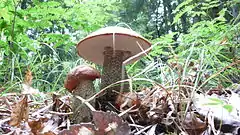Leccinum atrostipitatum
Leccinum atrostipitatum, also known as the dark-stalked bolete is a species of edible mushroom in the genus Leccinum.
| Leccinum atrostipitatum | |
|---|---|
 | |
| Leccinum atrostipitatum | |
| Scientific classification | |
| Kingdom: | |
| Division: | |
| Class: | |
| Subclass: | |
| Order: | |
| Family: | |
| Genus: | Leccinum |
| Type species | |
| Leccinum atrostipitatum | |
Description
L. atrostipitatum caps are 7–20 cm across, convex, dry, minutely hairy to fibril-streaked, and buff to yellow-orange or ochre. Flesh is white, staining grey, then black. Tubes are grey-brown, staining as flesh. Pores are small, round and smokey to blackish-brown. Stalks are up to 20 cm tall by 3.5 cm wide, whitish, and with many raised, black dots. Spore print is yellow-brown to olive. Dark-Stalked Bolete fruits on the ground in mixed woods.[1]
Leccinum is a genus of fungi in the family Boletaceae. It was the name given first to a series of fungi within the genus Boletus, then erected as a new genus last century. Their main distinguishing feature is the small, rigid projections (scabers) that give a rough texture to their stalks. The genus name was coined from the Italian Leccino, for a type of rough-stemmed bolete. The genus has a widespread distribution, especially in north temperate regions, and contains about 75 species.[2]

Ecology and habitat

Dark-Stalked Boletes fruit on the ground in mixed woods.
"Leccinum species are generally found in the woodlands of Europe, Asia, and North America, forming ectomycorrhizal associations with trees. Most Leccinum species are mycorrhizal specialists, associating with trees of a single genus. Leccinum aurantiacum is an exception, however, occurring in mycorrhizal association with poplar, birch, and oak.[3]
Edibility
L. atrostipitatum is a very good edible mushroom,[4] as are Leccinum species in general for the most part. However, there are reports of gastric upset after consuming unidentified members of the genus in North America, even after thorough cooking. Certain species, such as L. insigne, are suspected (but not confirmed) to cause gastric upset after consumption. Most species of Leccinum often cause nausea when consumed raw, therefore insufficient cooking or inconsistent heating needs to be acknowledged as a consideration in these cases. [5][6][7]
The key to safe and successful cooking Leccinum species like this is preparation. A dry-saute is best. Clean and slice the mushrooms, then put them in a skillet on maximum heat with no butter or oil. sprinkle them with salt (to help draw out the moisture). Stir constantly until they begin to give off liquid, then let them cook in their own juices. After the liquid has evaporated (you can pour off some of it for use as stock), continue to cook them for a couple of minutes, stirring constantly again so they do not stick. Then turn down the heat, add a little olive oil or butter, and cook for another 5–10 minutes. They should be fairly chewy and full of flavor, not slimy, You can eat them as they are or incorporate them into any dish.
References
- George Barron: Mushrooms of Northeast North America
- Kirk PM, Cannon PF, Minter DW, Stalpers JA (2008). Dictionary of the Fungi (10th ed.). Wallingford: CABI. p. 364. ISBN 978-0-85199-826-8.
- den Bakker, Henk C.; Zuccarello, G. C.; Kuyper, TH. W.; Noordeloos, M. E. (2004). "Evolution and host specificity in the ectomycorrhizal genus Leccinum" (PDF). New Phytologist. 163: 201–15. doi:10.1111/j.1469-8137.2004.01090.x. Archived from the original (PDF) on 2011-07-24.
- Phillips, Roger (2010). Mushrooms and Other Fungi of North America. Buffalo, NY: Firefly Books. p. 276. ISBN 978-1-55407-651-2.
- Beug, Michael W. (March–April 2004). "An Overview of Mushroom Poisonings in North America". The Mycophile. 45 (2): 4–5. Archived from the original on 2010-05-20.
- Beug, Michael W.; Shaw, Marilyn; Cochran, Kenneth W. (Fall 2006). "Thirty-Plus Years of Mushroom Poisoning: Summary of the Approximately 2,000 Reports in the NAMA Case Registry" (PDF). McIlvainea. North American Mycological Society. 16 (2): 47–68. Archived from the original (PDF) on 2010-12-21.
- Beug, Michael W. "NAMA Toxicology Committee Report for 2007: Recent Mushroom Poisonings in North America". Archived from the original on 2008-11-13. Retrieved 2011-04-04.